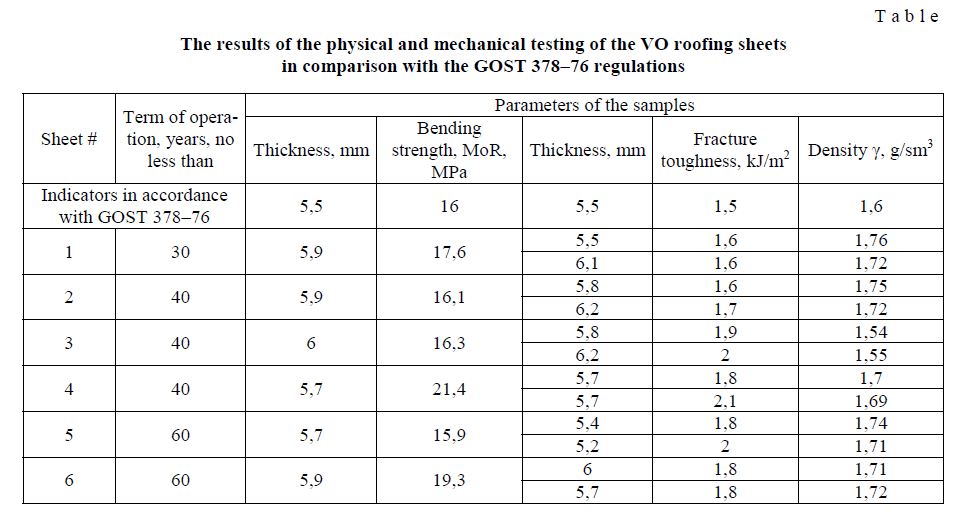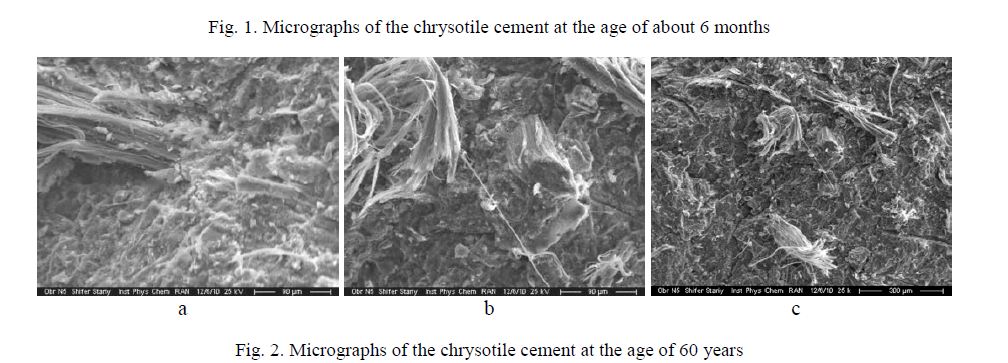The modern market of the roofing materials is very wide. Choice of this or any other roofing material requires an integrated approach. Many factors should be considered. Among them design and aesthetic requirements as well as the environmental conditions of its operation and last but not least, the financial capacity of a building contractor.
According to the price-quality trade-off chrysotile cement sheets are top-ranked among the industrial manufactured products for pitched roofs. These products, with more than a century of history, are used practically all over the world. They are simple in manufacturing and roofing installation, light (14 kg/m² comparing to the ceramic tiles — up to 70 kg/m²), whereas, not expensive and durable.
The most active period of the chrysotile cement production around the world was in the 50–70s of the XX century due to the necessity of the housing stock restoration and the infrastructure rehabilitation of the participating countries in the Second World War. A large number of enterprises appeared in the USSR. 58 plants worked in the country by the end of 1990-ies. Currently, the age of the roofs on some buildings, built in that period, is more than 60 years. There are examples of a much longer term of the successful chrysotile cement roofs operation. In the west of Russia and in Ukraine even now there are the roofs made of thin flat tile 4 mm thick, which were manufactured at the first slate plant in Russia (launched in 1908) in Fokino town, Bryansk region [1]. The exact date of the tiles manufacturing is unknown, but it is known that the production of the flat roofing tiles was discontinued in the late 20-ies of the 20th century, when the production of the corrugated sheets was adjusted. Therefore, chrysotile cement «tiles» on these houses are more than 80 years old. The houses under these tiles were rebuilt 2 — 3 times, and the tiles were restored to the roof.
After decades of the operation term chrysotile cement roofing sheets are still on the roofs in many regions of Russia and other countries in different climatic zones and retain their main properties: to hold water, to withstand snow loads and to protect from UV light and radiation. The real long-term operation of the chrysotile cement products give an evidence of the actual retention of their physical and mechanical characteristics during the whole term of operation. At that the operating life of chrysotile cement is not limited after the sheet is removed from the roof or after the passage of its main crack.
In the literature the information about the physical and mechanical characteristics of the tiles and sheets after such a long period of operation is not found. Their size is regulated by the normative documents only for the production aged 7–28 days and during the receiving of the production consignment by the project owner. At the same time, the investigation of changes in the chrysotile cement roofing sheets building performance in the process of long-term operation are of a considerable interest. Supporters of an antiasbestos campaign, which began about 30 years ago, are speaking about the air pollution by the fibers, which, as they claim, are allocated from the surface of the chrysotile cement sheets in the process of the operation. In the western literature there is even a calculation data on the exit velocity of the fibres from the sheet products. At the specified speed of the exit velocity of the fibres the chrysotile cement sheets would have simply dissolved into thin air within the space of 50 years after their installation on the roof. However, in the literature there is no experimental data on the change of the sheet thickness and other physical and mechanical properties of the material.
To obtain the information about the degree of the chrysotile cement roofing sheets integrity, including their thickness in the process of the long-term operation in the present study we tested the VO roofing sheets (corrugated roofing sheets), manufactured by the plant «Krasny Stroitel» in Voskresensk. VO roofing sheets are no more commercially available for more than 30 years; sheet size — 1200×686 mm, thickness not less than 5.5 mm (in accordance with GOST 378–76 «Asbestos-cement corrugated sheets of standart profile and details for them»). Operated products were on the roofs of private houses in the Shifernyj town, Moscow region. The age of the sheets is 30, 40 and 60 years as it was subjectively defined on the basis of the data with which the buildings owners furnished us. Some roofing sheets by the time of sampling after being removed from the roofs were kept outdoors by the owners. The surface of the sheets was contaminated with dust, they were partly covered by the moss growth. For testing we took sheets without any visible damages of the surface. On account of the small number of selected sheets we failed to spend statistically reliable test. For preliminary testing we sawed out one sample from each roofing sheet to determine the bending stress and two to determine the fracture toughness and density.
Physical and mechanical tests of the selected sheets are performed in accordance with the current GOST 8747–88 «Asbestos-cement sheet products. Methods of testing» in August 2010 in the industrial laboratory of the plant «Krasny stroitel» Ltd. The results are shown in the Table.
The results of the physical and mechanical testing of the VO roofing sheets in comparison with the GOST 378–76 regulations
T a b l e

Given the fact that there was small number of tested specimens, for greater reliability of the findings index listed in the table is not average, but includes all the subproduct test results: bending strength — 6 samples, other indicators — 12. As a comparison in the top row of the table there are normative indicators of the products according to GOST 378–76.
The given data shows that the thickness of the roofing sheets as well as their physical and mechanical characteristics are within the requirements of the standards for almost all tested samples. Only 2 samples out of 18 have thickness that is 2–5 % below normal, density of two samples out of 12 is lower by 3–4 %. There under we can conclude that during the entire operation period within 30–60 years in the climatic conditions of Moscow region the physical and mechanical properties of the VO chrysotile cement roofing sheets comply with the requirements of the GOST (the initial parameters), applicable at the time of the roofing sheets manufacture.
In this case, it is important to note the complicated ecological mode of operation of the sheets in Voskresensk district, Moscow region, with a large number of the changes of temperature and humidity extremes, which are typical for the region, the sheets were also effected by the pollution from the operation of the chemical plant being once the most powerful in the Soviet Union (26 production lines) and cement plants.
Whereas the adopted regulations for the ultimate bending strength, density and fracture toughness as to the SV-40 corrugated roofing sheets, which are manufactured at the present time according to GOST 30340– 95 «Asbestocement corrugated sheets. Technical requirements» are consistent with the requirements of GOST 378–76 to VO roofing sheets, there is no reason for assumption of another mode of modern products behavior in the process of their operation.
The record of properties invariance of the chrysotile cement sheets samples with the term of operation up to 60 years under natural conditions have not revealed any deviations from the regulations, which once again proved the reputation of the chrysotile cement roofing sheets as a long-lasting material. High physicalmechanical properties of the chrysotile cement are determined by unique properties of a natural fibrous mineral chrysotile, as well as unique and layer-by-layer press-filter technology with the reinforcement of thin films by the chrysotile fibers [2, 3], as a result of which a multi-layered composition of the portland cement and chrisotile fibers is formed.
During the test we revealed the immutability of the chrysotile cement sheets thickness in the process of their operation, which allows to refute reliably the allegations of the possibility of the chrysotile fibres allocation, because in order to release the fibres from the cement matrix one layer after another must be destroyed, that would just lead to a decrease in the thickness of the products.
Also in the course of the test we studied the condition of the surface of the chrysotile cement samples taken from the sheets of various age and the character of chrysotile fibers allocation on the surface. For comparison, samples were taken from the SV-40 sheets of about six months and VO sheets being in use for about 60 years.
Fresh spall of the samples was studied using scanning electron microscope JSM-U3, JEOL company (Japan) and x-ray spectrometer with the energy dispersion of the GETAC company (Germany). The test was carried out in the Russian academy of sciences A.N.Frumkin Institute of Physical chemistry and Electrochemistry RAS (IPCE RAS). Samples were fastened onto a graphite substrate with the help of a doublesided conductive adhesive tape. To provide the conductivity to the object we applied a layer of carbon with thickness of a few nanometers by vacuum thermal evaporation method. The objects were viewed at an accelerating voltage of 25 kV and current of the electron beam in about 10–9A.
From the given pictures (fig. 1, 2) we can see that the structure of the surface of the chrysotile cement samples, which have substantially different terms of operation, is close as to the outline of the cement matrix grains, but there is a difference of its density degree: as for the samples of 6 months, their structure is looser, it has more substancial breaches of continuity in the form of long and wide gaps than the one of the 60 years samples, wich has more extensive violations of the continuity as long and wide cracks.
This clearly shows that with ageing of the chrysotile cement products the degree of the chrysotile fibers consolidation in the cement matrix is increasing at the expense of the porosity reducing of the material, increase of the fibres reduction strength by the matrix and, obviously, at the expense of the more active cooperation between the hardening portland cement and chrysotile fibers. There is no difference between the samples of different age in the location of the chrysotile beams and of individual fibers in the matrices of the hardened portland cement. In all the pictures there are tight bundles of chrysotile and fibres, visible as separate. The ends of some of the beams remained in the matrix after the samples spalling (fig. 1a, 2a), the other are «sticking out» of the matrix (fig. 1b, c; 2b, c — are made at a different magnification). In our opinion, the lack of differences in the arrangement and consolidation of fibres gives an evidence of the chrysotile fibres retention in the cement matrix during the entire period of the product operation.

Fig. 1. Micrographs of the chrysotile cement at the age of about 6 months

Fig. 2. Micrographs of the chrysotile cement at the age of 60 years
Thus, the data obtained in the physico-mechanical testing of chrysotile cement roofing sheets with a significantly different operation and microscopic studies of their surface, shows immutability of the chrysotile cement properties during a long operation period. This data also serves as a refutation of the available in the publications statements that in the process of operation thickness of chrysotile cement products is reduced and chrisotile fibers are allocated from them into the atmosphere. The research has confirmed the advantages of the chrysotile cement roofing products from environmental, operational and economic points of view in comparison with many other roofing materials and products.
References
- Burnham I.I. The theory of forming asbestos-cement sheets and pipes. — M.: Stroiizdat,
- Komarov T. 100-year anniversary of the Bryansk asbestos factory // Build. Materials. — 2008. — № 9. — P. 34–35.
- Sokolov P.N. Technology of asbestos-cement products. — M.,